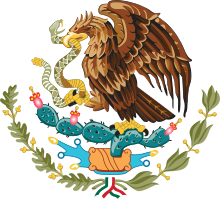Mexican Armed Forces
| Mexican Armed Forces Fuerzas Armadas de Mexico |
|
|---|---|

Mexican Coat of arms
|
|
| Founded | August 21, 1884 |
| Service branches |
Mexican Army Mexican Air Force Mexican Navy |
| Headquarters | Mexico City |
| Leadership | |
| Commander-in-chief |
|
| Secretariat of National Defense | General Salvador Cienfuegos Zepeda |
| Secretariat of the Navy | Admiral Vidal Francisco Soberón Sanz |
| Manpower | |
| Military age | 16–49 |
| Available for military service |
59,179,064 males, age 16–49, 59,179,064 (2011 est.) females, age 16–49 |
| Fit for military service |
48,882,415 males, age 16–49, 48,882,415 (2011 est.) females, age 16–49 |
| Reaching military age annually |
2,172,378 males, 1,072,094 (2011 est.) females |
| Active personnel | 280,000 (2013 est.) (ranked 28 of 166) |
| Expenditures | |
| Budget | $11.6 billion (2014 est.) |
| Percent of GDP | 0.6% (2014 est.) |
| Industry | |
| Foreign suppliers |
|
The Mexican Armed Forces (Fuerzas Armadas de México) are composed of two independent entities: the Mexican Army and the Mexican Navy. The Mexican Army includes the Mexican Air Force (FAM). The Presidential Guard, Military Police, and Special Forces are part of the Army, but have their own chains of command. The Mexican Navy includes the Naval Infantry Force and the Naval Aviation (FAN).
The Army and Navy are controlled by two separate government departments, the National Defense Secretariat and the Naval Secretariat, and maintain two independent chains of command, with no joint command except the President of Mexico.
There are three main components of the Army: a national headquarters, territorial commands, and independent units. The Minister of Defense commands the Army by means of a very centralized system and a large number of general officers. The Army uses a modified continental staff system in its headquarters. The Army is the largest branch of Mexico's armed services.
Presently, there are 12 "Military Regions", which are further broken down into 44 subordinate "Military Zones." In both cases, a numbering system is used for designation. There is no set number of zones within a region, and these can therefore be tailored to meet operational needs, with a corresponding increase or decrease in troop strength.
The Air Force national headquarters is embedded in the Army headquarters in Mexico City. It also follows the continental staff system, with the usual A1, A2, A3, and A4 sections. The tactical forces form what is loosely called an Air Division, but it is dispersed in four regions: Northeast Mexico, Northwest Mexico, Central Mexico, and Southern Mexico. The Air Force maintains a total of 18 air bases, and has the additional capability of opening temporary forward operating bases in austere conditions for some helicopters and light aircraft.
The Ministry of the Navy, the Navy's national headquarters, is located in Mexico City, and is smaller than the Army's headquarters. The "Junta (or Council) of Admirals" plays a unique consultative and advisory role within the headquarters, an indication of the institutional importance placed on seniority and "year groups" that go back to the admirals’ days as cadets in the naval college. They are a very tightly knit group, and great importance is placed on consultation among the factions within these year groups. The Navy's operational forces are organized as two independent groups: the Gulf Force and the Pacific (West) Force. Each group has its own headquarters, a destroyer group, an auxiliary vessel group, a Marine Infantry Group, and a Special Forces group. The Gulf and Pacific Forces are not mirror images of each other, as independence of organization is permitted. Both are subdivided into regions, with Regions 1, 3, and 5 on the Gulf, and 2, 4, and 6 on the Pacific. Each region is further divided into sectors and zones, so a proliferation of headquarters and senior officers exists. The Navy also has an air arm with troop transport, reconnaissance, and surveillance aircraft.
...
Wikipedia
